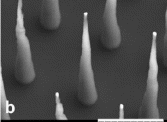 Free Science Home
Free Science Homepersonal home page of
Anatoli V. Melechko
doi:10.1016/j.carbon.2005.12.010
Copyright © 2006 Elsevier Ltd All rights reserved.
Carbon
Full text PDF
Control of catalyst particle crystallographic orientation in vertically aligned carbon nanofiber synthesis
J.D. Fowlkesa,
b,
 ,
,
 ,
A.V. Melechkoa,
b,
K.L. Kleina,
b,
P.D. Rackb,
D.A. Smithb,
D.K. Hensleya,
c,
d,
M.J. Doktyczd,
e
and M.L. Simpsona,
b,
c,
d
,
A.V. Melechkoa,
b,
K.L. Kleina,
b,
P.D. Rackb,
D.A. Smithb,
D.K. Hensleya,
c,
d,
M.J. Doktyczd,
e
and M.L. Simpsona,
b,
c,
d
aMolecular-Scale Engineering and Nanoscale Technologies Research Group, Oak Ridge National Laboratory, P.O. Box 2008, MS 6006, Oak Ridge, TN 37831-6006, United States
bMaterials Science and Engineering Department, The University of Tennessee, Knoxville, TN 37996-2200, United States
cCondensed Matter Sciences Division, Nanobiological Materials Sciences, Oak Ridge National Laboratory, P.O. Box 2008, MS 6033, Oak Ridge, TN 37831-6033, United States
dCenter for Nanophase Materials Sciences, Oak Ridge National Laboratory, Oak Ridge, TN 37831-6056, United States
eLife Sciences Division, Oak Ridge National Laboratory, P.O. Box 2008, MS 6123, Oak Ridge, TN 37831-6123, United States
Received 23 March 2005; accepted 6 December 2005. Available online 24 January 2006.
Abstract
Vertically aligned carbon
nanofibers (VACNF) have been
synthesized where the
crystallographic orientation
of the initial catalyst film
was preserved in the
nanoparticle that remained
at the nanofiber tip after
growth. A substantial
percentage of catalyst
particles (75%), amounting
to approximately 200 million
nanofibers over a 100 mm Si
wafer substrate, exhibited a
sixfold symmetry attributed
to a cubic Ni(1 1 1) Si(0 0 1)
orientation relationship
which was verified by X-ray
diffraction studies. The Ni
catalyst films were prepared
by rf-magnetron sputtering
under substrate bias
conditions to yield a single
(1 1 1) film texture. The
total energy of the Ni thin
film was estimated by
calculating the sum of the
surface free energy and
strain energy. The total
film energy was minimized by
the evolution of the plane
of lowest surface free
energy, the (1 1 1) texture.
This result was in agreement
with X-ray diffraction
measurements. The preferred
orientation present in the
Ni catalyst film prior to
nanofiber growth was
preserved in the Ni catalyst
particles throughout the
VACNF growth process. The Ni
catalyst particles at the
nanofiber tips were not pure
single crystals but rather
consisted of a mosaic
structure of Ni
nanocrystallites embedded
within Ni catalyst
nanoparticles (200–400 nm).
The tip-located
nanoparticles exhibited a
faceted, crystal morphology
with the faceting
transferred to the
underlying carbon nanofiber
during the growth process.
The possibility of precisely
and accurately controlling
VACNF growth velocity over
macroscopic wafer dimensions
with uniformly aligned
catalyst particles is
discussed.
Si(0 0 1)
orientation relationship
which was verified by X-ray
diffraction studies. The Ni
catalyst films were prepared
by rf-magnetron sputtering
under substrate bias
conditions to yield a single
(1 1 1) film texture. The
total energy of the Ni thin
film was estimated by
calculating the sum of the
surface free energy and
strain energy. The total
film energy was minimized by
the evolution of the plane
of lowest surface free
energy, the (1 1 1) texture.
This result was in agreement
with X-ray diffraction
measurements. The preferred
orientation present in the
Ni catalyst film prior to
nanofiber growth was
preserved in the Ni catalyst
particles throughout the
VACNF growth process. The Ni
catalyst particles at the
nanofiber tips were not pure
single crystals but rather
consisted of a mosaic
structure of Ni
nanocrystallites embedded
within Ni catalyst
nanoparticles (200–400 nm).
The tip-located
nanoparticles exhibited a
faceted, crystal morphology
with the faceting
transferred to the
underlying carbon nanofiber
during the growth process.
The possibility of precisely
and accurately controlling
VACNF growth velocity over
macroscopic wafer dimensions
with uniformly aligned
catalyst particles is
discussed.
Keywords:
Carbon fibers;
Catalyst; Plasma sputtering;
X-ray diffraction; Phase
transitions
![]()
 Corresponding
author. Address: Materials
Science and Engineering
Department, The University
of Tennessee, Knoxville, TN
37996-2200, United States.
Fax: +1 865 974 4115.
Corresponding
author. Address: Materials
Science and Engineering
Department, The University
of Tennessee, Knoxville, TN
37996-2200, United States.
Fax: +1 865 974 4115.
